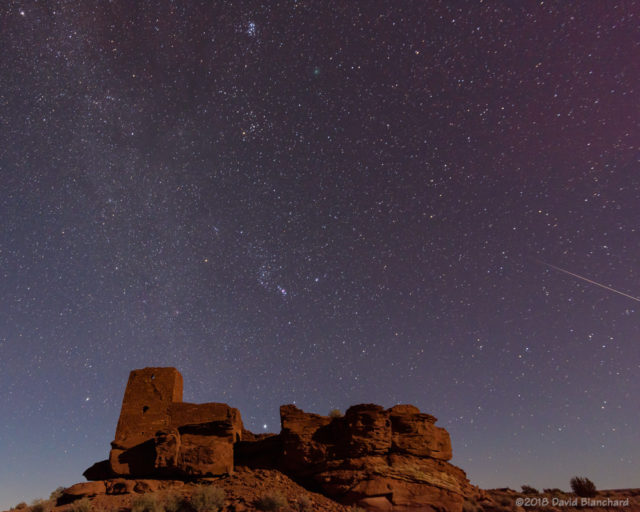The past few nights have been interesting. On the evening of December 13–14 was the peak of the Geminid meteor shower. This year the expected peak was around 100–120 meteors per hour and various meteor counts appear to confirm that number.
At the same time, Comet 46P/Wirtanen has been getting a lot of attention. On December 16 it made its closest approach to Earth—only 11.5 million km away. That’s about 30 lunar distances for reference.
From SpaceWeather.com: “Although the comet is very close to Earth, it is not very bright. 46P/Wirtanen is a relatively small comet and, thus, barely visible to the unaided eye despite its proximity. It is nevertheless an easy target for digital cameras. Even a short exposure reveals the comet’s spherical form and emerald green hue.”
During the late evening of December 13, I traveled to Wupatki National Monument because of its dark skies. I shot a sequence of photos—each of 30 seconds duration—of the night sky hoping to catch a few meteors. One bright meteor blazed across the sky and I was able to catch part of it before it moved out of the frame of the camera. At the same time, the crescent Moon was setting in the west and gently illuminating Wukoki Pueblo. At the very top center of the photograph is Comet 46P/Wirtanen.

After about 1/2 hour of shooting meteors, I shot longer exposures of the comet. On this night, the comet formed a triangle with the Pleiades and Hyades star clusters. The image shown here is from ten 60-second images stacked using Deep Sky Stacker (DSS) and post-processed using rnc-color-stretch.

A few nights later, the comet had moved so that it was between the Pleiades and Hyades clusters. Again, I shot a sequence of 60-second exposures totaling about one hour in duration—this time from the Mormon Lake overlook. The motion of the comet is quite apparent in this sequence of images. The first image shows the motion of the comet against the stars; the second is a time-lapse movie of the same sequence.

Time lapse movie showing the motion of Comet 46P/Wirtanen during a period of one hour.
Comet 46P/Wirtanen is now moving farther from Earth and will slowly dim in brightness but it will remain visible through binoculors, telescopes, and with digital cameras for many weeks or more. There is still plenty of time to see the comet if you haven’t already.